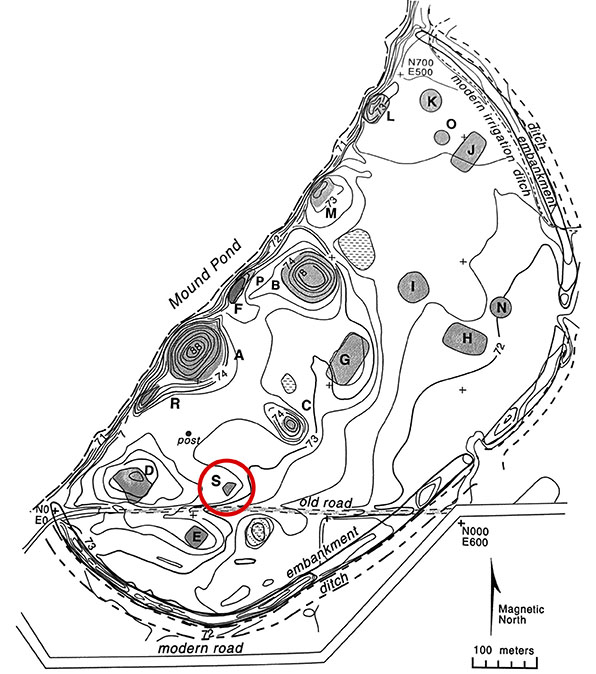
Dr. Paige A. Ford, PBRS Research Station
Feature of the Month - December 2022
Mound S, a feasting mound at Plum Bayou Mounds Archeological State Park, is the December Feature of the Month.
Plum Bayou Mounds is a ceremonial mound center located near Scott, Arkansas in Lonoke County. Built by the Plum Bayou people during the Terminal Late Woodland period (AD 650-1050), the site consists of 18 earthen mounds and two plazas surrounded by an earthen embankment wall on three sides and an oxbow lake on the fourth. Mounds are interesting constructions in many regards. Such earthworks themselves are features on the landscape constructed by past peoples, and in constructing these large features, those same people left behind features inside of them as well. In other words, mounds are not just constructions that took place all in one go. They contain many features inside of them—fire pits, middens, postholes, and more—that tell us a story of what they were utilized for by people like the Plum Bayou.
Plum Bayou Mounds is a ceremonial center, meaning people did not live at this site year-round. Rather, individuals and communities would travel from the surrounding region to this site for rituals, feasts, and other religious and ceremonial events. Each mound at the site has a different story to tell about these activities; each mound contains ritual artifacts, evidence of public structures, and middens, showing us evidence of feasting events, and more. Mound S—the focus of this feature of the month—is interpreted as a feasting mound, containing middens with large amounts of burned animal bone, cutting tools, as well as ceramic sherds of cooking and serving vessels.
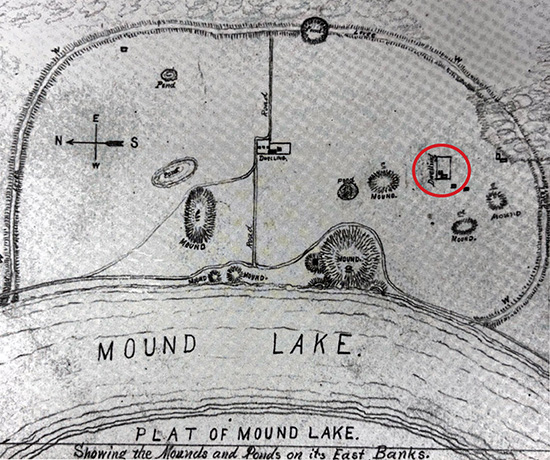
According to Dr. Martha Rolingson (2012:39), Mound S was first encountered during excavations in 1979 and was subsequently investigated by the Arkansas Archeological Survey (ARAS) as part of the Arkansas Archeological Society’s (AAS) Training Program from 1988-1990. Unidentified in historic documents, maps, or accounts of the site, it was indicated by a slight rise consistent with a mound remnant in their topographic map. It is located on the southeastern edge of the southern plaza at the site, between Mounds C and E (Figure 1).
Earthen mounds are often quite prominent features on the landscape, but many have been impacted by human activity through the centuries of their existence. Mound S is one such monument. This mound was probably quite low in its original height (maybe not any higher than 60 cm), but nonetheless was heavily impacted by human activity in the nineteenth and twentieth centuries. Some clues to what may have happened to this mound are indicated in historic maps of the site, including one drawn by H. J. Lewis who was visiting Plum Bayou Mounds with Edward Palmer of the Smithsonian Institution in December 1882 (Figure 2). He sketched a large structure with several smaller buildings in the vicinity of Mound S. Considering this portion of the site had also been cultivated for decades prior to the Smithsonian investigations, it is likely that Mound S had almost been leveled by the time those structures were built between 1879 and 1882. More extensive farming activities in the 1960s and 1970s continued this leveling and by the time of Dr. Rolingson’s excavations, Mound S was unidentifiable as an earthen monument outside of topographic maps (Rolingson 2012:43).
ARAS and AAS excavated Mound S extensively and because of that we can tell about the construction and use of this low earthen mound for feasting. The full story of this mound is illuminated through a series of smaller features within the mound itself. It was a single-stage construction, built around AD 670 to 800, though the mound has evidence of use in later time periods as well (Rolingson 2012:68). Prior to the actual mound construction, there is evidence of a pre-mound midden, illustrating that this space was utilized prior to the actual construction of the mound itself. This pre-mound midden consisted of a homogenous soil matrix with numerous small pits such as Feature 46, a circular pit feature which contained some charcoal (Figures 3 and 4). These pits were found in concert with many potential post molds. The many features in this pre-mound midden illustrate that Plum Bayou people were utilizing this space beneath Mound S prior to even constructing the mound. They had delineated this space as an area for their use as a cooking area even before they constructed this mound.
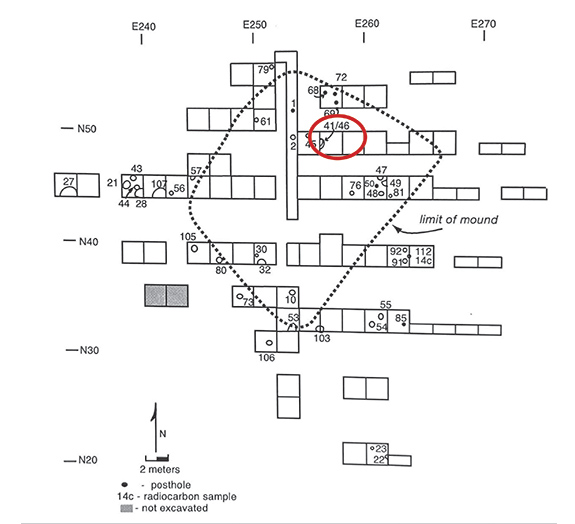
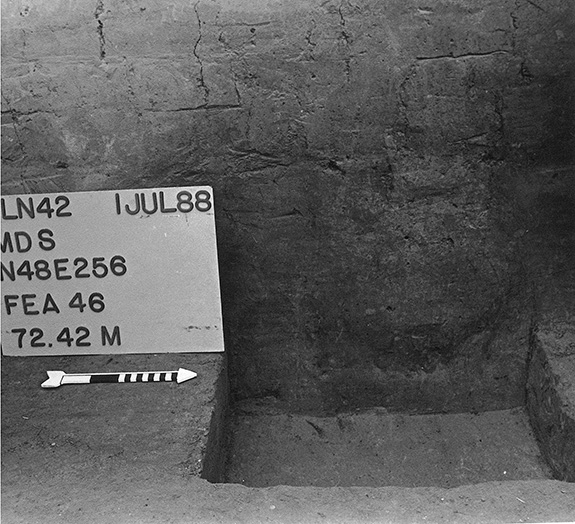
As stated previously, Mound S was a single-stage construction, meaning its platform was built all in one go. Many mounds are built in multiple stages, with successive filling episodes at various points in the earthwork’s use, but Mound S was built in one stage. Plum Bayou peoples used basket loads of soil to build these features, and archeologists can see these basket loads in the stratigraphy of the soil itself (Figure 5). The fill of the platform mound itself had some artifacts and contained some evidence of pointed post molds, though no patterns could be illuminated to suggest a structure was present. Since there are Plum Bayou artifacts in the soil, the fill of this mound illustrates that Plum Bayou peoples constructed this low mound using soil from around the site, potentially borrow pits that are nearby Mound B and the embankment wall.
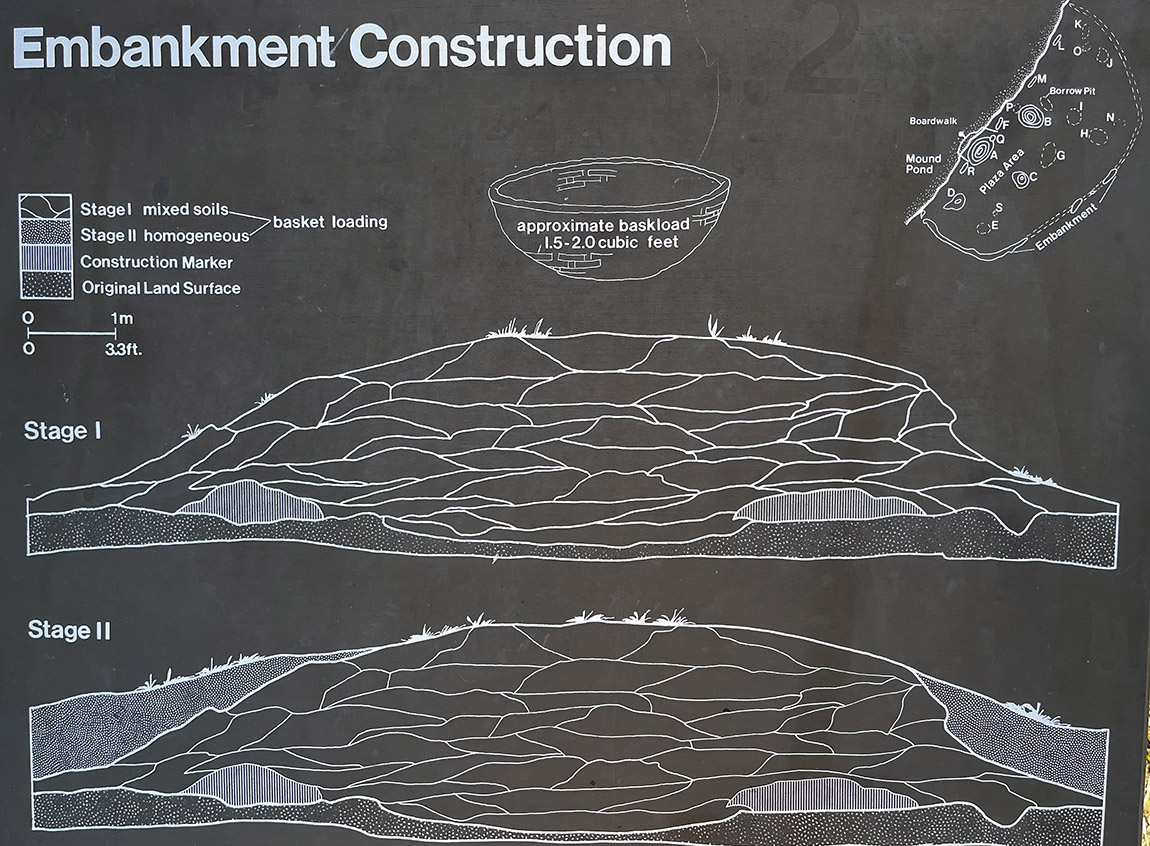
A final feature I want to discuss within Mound S is the slope midden (Figure 6). This is a concentrated deposit of lots of animal bone and artifacts that is located on the southeastern and eastern side (Rolingson 2012:49-53). This is the main feature that tells us the story of Mound S as a feasting mound. This slope midden is larger in extent than the mound, suggesting that the food and related debris found there were deposited over several occasions. While the midden primarily consisted of animal bone, it also included charcoal fragments, sherds, broken cutting tools, and lithic debris. The animal bone itself was very well preserved and some showed evidence of burning and cutting. The remains primarily consist of white-tailed deer and turkey, though many other animal taxa are represented as well.
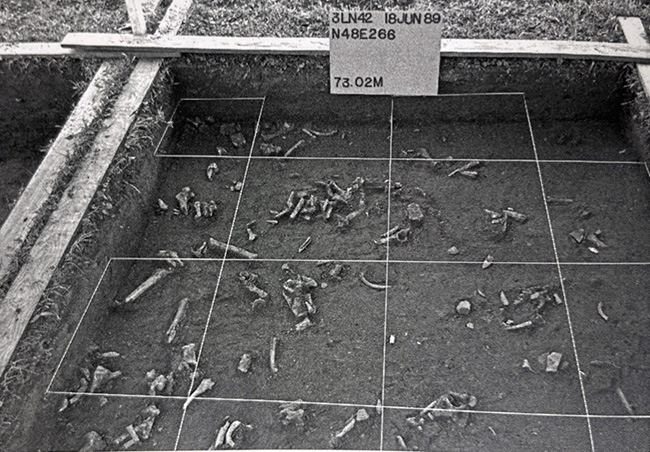
According to Kelly (2012:150), feasting activities at Mound S are indicated by the high meat-yielding species such as deer and turkey being the predominant remains found. This means that Plum Bayou people were of course serving animals that produced lots of food for lots of people who were attending the feasts and rituals held on site. There were also several rare animal species found in the faunal assemblage, which can be related to rituals and may not have been consumed. The rare species found at Mound S include black bear, white pelican, and bald eagle.
While the faunal data alone from this slope midden on Mound S illustrate to us that this space was utilized for feasting activities, other artifacts and data support this conclusion. The slope midden and its location on the platform show evidence of special food disposal consistent with short-term feasting events rather than long-term domestic food disposal. The midden also contains many lithic tools including arrow points and fragments utilized in killing the animals present in the midden, expedient flake tools that can be manufactured quickly and utilized in butchering and processing animals, as well as hafted tools for these same purposes. Some ground stone artifacts such as pipes, disk beads, and a sandstone tablet illustrate nonutilitarian objects that may have been utilized in ritual feasting. The Mound S slope midden assemblage also has a high percentage of bowls for serving food with the remainder comprising jars with evidence of cooking residue and fire damage. All of these data illustrate to us that Mound S was the result of communal feasting activities (Rolingson 2012:153-159).
All in all, the above discussion hopefully illustrates that archeologists can reconstruct the stories of large features (like earthen mounds) at archeological sites through the combination of studying the constructions themselves as immovable remnants of human activity, but also analyzing the features found within them. The pre-mound midden and associated post molds and pits at Mound S show us that this space was utilized prior to the mound’s construction. While the mound fill itself shows us that they were utilizing basket loads of soil from adjacent parts of Plum Bayou Mounds to construct the earthwork itself. And finally, the slope midden illustrates that the activities that most likely took place at Mound S were communal feasting events. These features, taken together, all fit within the larger story of the ceremonial activities that took place at Plum Bayou Mounds.
References
Rolingson, Martha Ann
1998 Toltec Mounds and Plum Bayou Culture: Mound D Excavations. Arkansas Archeological Survey Research Series 54.
2012 Toltec Mounds: Archeology of the Mound-and-Plaza Complex. Arkansas Archeological Survey Research Series 65.
Kelly, Lucretia S.
2012 Faunal Remains from Mound S Toltec Mounds Site. In Toltec Mounds: Archeology of the Mound-and-Plaza Complex by Martha Ann Rolingson, Arkansas Archeological Survey Research Series 65, pp. 123-151.
Feature of the Month Series
Archeological features are elements or structures that are nonportable or cannot be easily removed from a site (such as a wall or a post hole). Archeologists document archeological features extensively in the field to record what will otherwise be destroyed in the process of excavation. The records of these features are often all that is left at the end of an excavation. Excellent record keeping is necessary for these features to provide insight into the archeological record and site formation.
In this series, we present interesting and important archeological features that have helped archeologists to better or more fully understand the sites on which they were working. New features will be added monthly. Find the list of features here.
